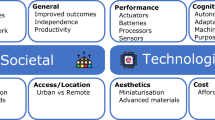Abstract
Purpose Most medical robotic systems require direct interaction or contact with the robot. Force–Torque (FT) sensors can easily be mounted to the robot to control the contact pressure. However, evaluation is often done in software, which leads to latencies.
Methods To overcome that, we developed an independent safety system, named FTA sensor, which is based on an FT sensor and an accelerometer. An embedded system (ES) runs a real-time monitoring system for continuously checking of the readings. In case of a collision or error, it instantaneously stops the robot via the robot’s external emergency stop.
Results We found that the ES implementing the FTA sensor has a maximum latency of \(1\pm 0.03\) ms to trigger the robot’s emergency stop. For the standard settings in the application of robotized transcranial magnetic stimulation, the robot will stop after at most 4 mm.
Conclusion Therefore, it works as an independent safety layer preventing patient and/or operator from serious harm.









Similar content being viewed by others
References
Adler JR Jr, Chang SD, Murphy MJ, Doty J, Geis P, Hancock SL (1997) The CyberKnife: a frameless robotic system for radiosurgery. Stereotact Funct Neurosurg 69:124–128. doi:10.1159/000099863
Baik SH (ed) (2010) Robot surgery. InTech, Vukovar, Croatia
Benabid A, Cinquin P, Lavalle S, Le Bas J, Demongeot J, De Rougemont J (1987) Computer-driven robot for stereotactic surgery connected to ct scan and magnetic resonance imaging. Stereotact Funct Neurosurg 50(1-6):153–154
Bozovik V (ed) (2008) Medical robotics. InTech, Vienna, Austria
Craig JJ (2005) Introduction to robotics: mechanics and control, 3rd edn. Prentice Hall, Englewood Cliffs
Dombre E, Duchemin G, Poignet P, Pierron F (2003) Dermarob: a safe robot for reconstructive surgery. IEEE Trans Robotics Autom 19(5):876–884. doi:10.1109/tra.2003.817067
Drake JM, Joy M, Goldenberg A, Kreindler D (1991) Computer-and robot-assisted resection of thalamic astrocytomas in children. Neurosurgery 29(1):27
Kwoh YS, Hou J, Jonckheere E, Hayati S (1988) A robot with improved absolute positioning accuracy for ct guided stereotactic brain surgery. IEEE Trans Biomed Eng 35(2):153–160
Lancaster JL, Narayana S, Wenzel D, Luckemeyer J, Roby J, Fox P (2004) Evaluation of an image-guided, robotically positioned transcranial magnetic stimulation system. Hum Brain Mapp 22(4):329–340. doi:10.1002/hbm.20041
Lanfranco AR, Castellanos AE, Desai JP, Meyers WC (2004) Robotic surgery: a current perspective. Ann Surg 239(1):14
Lebossé C, Renaud P, Bayle B, de Mathelin M, Piccin O, Foucher J (2007) A robotic system for automated image-guided transcranial magnetic stimulation. In: Life science systems and applications workshop, 2007, LISA 2007, IEEE/NIH, pp 55–58. doi:10.1109/lssa.2007.4400883
Li QH, Zamorano L, Pandya A, Perez R, Gong J, Diaz F (2002) The application accuracy of the NeuroMate robot–a quantitative comparison with frameless and frame-based surgical localization systems. Comput Aided Surg 7(2):90–98
Matthäus L (2002) A robotic assistance system for transcranial magnetic stimulation and its application to motor cortex mapping. Ph.D. thesis, Universität zu Lübeck
Matthäus L, Giese A, Wertheimer D, Schweikard A (2006) Planning and analyzing robotized tms using virtual reality. Stud Health Technol Inform 119:373–378
Matthäus L, Trillenberg P, Bodensteiner C, Giese A, Schweikard A (2006) Robotized TMS for motion compensated navigated brain stimulation. In: Computer assisted radiology and surgery (CARS), 20th international congress. Osaka, Japan
Medtech: Rosa neurosurgery robot. Tech. rep., Medtech SAS, Montepllier, France (2011) http://www.medtechsurgical.com/products/ROSA
Morgan PS, Carter T, Davis S, Sepehri A, Punt J, Byrne P, Moody A, Finlay P (2003) The application accuracy of the pathfinder neurosurgical robot. International congress series CARS 2003. Computer Assisted Radiology and Surgery. Proceedings of the 17th international congress and Exhibition, pp 561–567
Renaud P, Piccin O, Lebossé C, Laroche E, de Mathelin M, Bayle B, Foucher J (2006) Robotic image-guided transcranial magnetic stimulation. In: Computer assisted radiology and surgery (CARS), 20th international congress. Osaka, Japan
Richter L, Bruder R, Schweikard A (2012) Calibration of force/torque and acceleration for an independent safety layer in medical robotic systems. Cureus 4(9):e59. doi:10.7759/cureus.59
Richter L, Bruder R, Schweikard A (2012) Hand-assisted positioning and contact pressure control for motion compensated robotized transcranial magnetic stimulation. Int J Comput Assist Radiol Surg 1–8 [Epub ahead of print]. doi:10.1007/s11548-012-0677-6
Schweikard A, Bodduluri M, Adler JR Jr (1998) Planning for camera-guided robotic radiosurgery. IEEE Trans Rob Autom 14(6):951–962. doi:10.1109/70.736778
Taylor RH (2006) A perspective on medical robotics. Proc IEEE 94(9):1652–1664. doi:10.1109/jproc.2006.880669
Yi X, Bicker R (2010) Design of a robotic transcranial magnetic stimulation system. In: IEEE conference on robotics, automation and mechatronics, Singapore
Zorn L, Renaud P, Bayle B, Goffin L, Lebossé C, de Mathelin M (2012) Design and evaluation of a robotic system for transcranial magnetic stimulation. IEEE Trans Biomed Eng 59(3):805–815. doi:10.1109/tbme.2011.2179938
Acknowledgments
This work was partially supported by the Graduate School for Computing in Medicine and Life Sciences funded by Germany’s Excellence Initiative [DFG GSC 235/1]. Conflict of interest None.
Author information
Authors and Affiliations
Corresponding author
Rights and permissions
About this article
Cite this article
Richter, L., Bruder, R. Design, implementation and evaluation of an independent real-time safety layer for medical robotic systems using a force–torque–acceleration (FTA) sensor. Int J CARS 8, 429–436 (2013). https://doi.org/10.1007/s11548-012-0791-5
Received:
Accepted:
Published:
Issue Date:
DOI: https://doi.org/10.1007/s11548-012-0791-5




